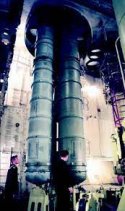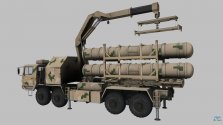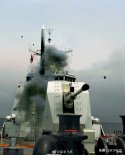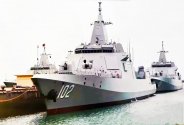You are using an out of date browser. It may not display this or other websites correctly.
You should upgrade or use an alternative browser.
You should upgrade or use an alternative browser.
055 DDG Large Destroyer Thread
- Thread starter FarkTypeSoldier
- Start date
- Status
- Not open for further replies.
Obvious counter examples are HHQ9 (cold launched SAM) and YJ18 (biggest known PLAN conventional missile before the new possible hypersonic-hot launched missile).
I don’t think there are any rules or conventions that the PLA follows when it comes to choosing between hot or cold launch for missiles, which is probably one of the main reasons it went for the UVLS that can accommodate both.
Thus, if they are navalising existing land based missiles, I think they will just keep whatever the launch method is from the land based systems for the naval version to save on costs to having to redesign existing missiles for a different launch method.
True for just about everything but for one important example. The HHQ-16. The land based HQ-16 is cold launched, but the naval HHQ-16 is hot launched. Why? This seems puzzling when the Russian counterpart, the Shtil, has its VLS being cold launched even though the land based Buk is fired off from a slanted position, which is a hot launch in a sort of way. But then again, the hot launched AJK-16 VLS was designed a long time ago when the modern PLAN was still in its infancy and looking to ape the West as models and examples, with the AJK-16 coming out as an indigenous copy of the Mk. 41. The U-VLS came at a time thereafter when the thought train became more independent. While the AJK-16 and the HHQ-16 were both technologically and operationally successful, the move to the U-VLS also meant they were dead ends. If the AJK-16 have been skipped, a shortened version of the U-VLS was used on the Type 054A instead, we might be seeing a cold launch HHQ-16.
I don’t think the difference in reaction time of a cold launched missile and hot launched missile makes a significant different to any application. The only difference is a cold launched missile can be larger than a hot launched missile for a given distance between the cell cell central axis in a VLS farm, but the cold launched missile has an additional point of failure.
plawolf
Lieutenant General
True for just about everything but for one important example. The HHQ-16. The land based HQ-16 is cold launched, but the naval HHQ-16 is hot launched. Why? This seems puzzling when the Russian counterpart, the Shtil, has its VLS being cold launched even though the land based Buk is fired off from a slanted position, which is a hot launch in a sort of way. But then again, the hot launched AJK-16 VLS was designed a long time ago when the modern PLAN was still in its infancy and looking to ape the West as models and examples, with the AJK-16 coming out as an indigenous copy of the Mk. 41. The U-VLS came at a time thereafter when the thought train became more independent. While the AJK-16 and the HHQ-16 were both technologically and operationally successful, the move to the U-VLS also meant they were dead ends. If the AJK-16 have been skipped, a shortened version of the U-VLS was used on the Type 054A instead, we might be seeing a cold launch HHQ-16.
Well you answered your own question didn’t you?
The HHQ16 is hot launched because of the AJK16 used on the 054A was hot launch only.
Having already developed a hot launched naval HHQ16, why would they go back to the drawing board to navalise the cold launched land based HQ16 again?
Personally, I think the technical and logistical costs involved in the hot launched HHQ16 played a big part in the PLAN decision to accommodate both launch methods with the UVLS.
With the UVLS, I think naval and land based missiles can have significant parts commonality, which will greatly reduce costs and ease logistics in actual war. Hell, I would not be surprised if naval and land based versions of most Chinese missiles can be interchangeably used in a pinch.
Well you answered your own question didn’t you?
The HHQ16 is hot launched because of the AJK16 used on the 054A was hot launch only.
Having already developed a hot launched naval HHQ16, why would they go back to the drawing board to navalise the cold launched land based HQ16 again?
Personally, I think the technical and logistical costs involved in the hot launched HHQ16 played a big part in the PLAN decision to accommodate both launch methods with the UVLS.
With the UVLS, I think naval and land based missiles can have significant parts commonality, which will greatly reduce costs and ease logistics in actual war. Hell, I would not be surprised if naval and land based versions of most Chinese missiles can be interchangeably used in a pinch.
The land and naval missiles should have major parts and frame commonality, but they should not be interchangeable. The naval missile seekers are adapted against the clutter of the sea, while the land missile seekers are meant to filter clutter from the land. Then there is also the fact that with both the HQ-9 and HQ-16, the fire control systems of land vs. naval are so different from each other, and the respective seekers are set to work for these.
When it comes to cold launched canisters, it won't surprise me to use the same canister for the HQ-9 in both sea and land versions, although the sea version might have a different requirement for a minimum height pop up. It would make sense, and it needs to be, that they have to use the same canister for both 052C circular VLS and the U-VLS, so the HQ-9 missiles between the two are interchangeable. I would expect the 052C's fire control systems for the HHQ-9 to be updated, without waiting for an MLU, to enable it to use the HHQ-9B.
For the HQ-16 the land and sea versions are using very different canisters, one a cylindrical and the other a square. If the HHQ-16 is re-adapted to U-VLS, assuming the 054B would use the U-VLS, they could revert back to a cold launch system and use the same cylindrical canister with cold gas pop up, instead of creating a new concentric canister for hot launch, unless they so desire to use the existing stock of hot launched missiles to the 054B.
antiterror13
Brigadier
The land and naval missiles should have major parts and frame commonality, but they should not be interchangeable. The naval missile seekers are adapted against the clutter of the sea, while the land missile seekers are meant to filter clutter from the land. Then there is also the fact that with both the HQ-9 and HQ-16, the fire control systems of land vs. naval are so different from each other, and the respective seekers are set to work for these.
When it comes to cold launched canisters, it won't surprise me to use the same canister for the HQ-9 in both sea and land versions, although the sea version might have a different requirement for a minimum height pop up. It would make sense, and it needs to be, that they have to use the same canister for both 052C circular VLS and the U-VLS, so the HQ-9 missiles between the two are interchangeable. I would expect the 052C's fire control systems for the HHQ-9 to be updated, without waiting for an MLU, to enable it to use the HHQ-9B.
For the HQ-16 the land and sea versions are using very different canisters, one a cylindrical and the other a square. If the HHQ-16 is re-adapted to U-VLS, assuming the 054B would use the U-VLS, they could revert back to a cold launch system and use the same cylindrical canister with cold gas pop up, instead of creating a new concentric canister for hot launch, unless they so desire to use the existing stock of hot launched missiles to the 054B.
Is it true that HHQ-9B is for UVLS only ? if it is the case ,052C/+ may not be able to get it
Is it true that HHQ-9B is for UVLS only ? if it is the case ,052C/+ may not be able to get it
I expect HHQ-9B to use the same cylindrical canister with rings and rounded ends as with previous HQ-9 and HHQ-9. If that's the case, it would be possible to use it on the 052Cs circular VLS, where it would basically hang from the top, similar to the RIF-M VLS below.


HQ-9B model
That's a CAMM. Each of Type 23's 32 VLS could quadpack them. So a Type 23 could carry 128 of these 30-40km range ASM interceptors. I look forward to seeing quadpacked medium-range SAM on 055s and 052Ds soon; hopefully by the end of this year and before the next major armed conflict. These ESSM-like medium-range quadpacked SAMs are vital to the survival of large surface combatants.
That's a CAMM. Each of Type 23's 32 VLS could quadpack them. So a Type 23 could carry 128 of these 30-40km range ASM interceptors. I look forward to seeing quadpacked medium-range SAM on 055s and 052Ds soon; hopefully by the end of this year and before the next major armed conflict. These ESSM-like medium-range quadpacked SAMs are vital to the survival of large surface combatants.
No.
Type 23's VLS for CAMM/Sea Ceptor are only able to carry one missile each tube.
Sea Ceptor is able to be quad packed in larger VLS like Mk-41. But the Type 23 is not equipped with Mk-41, rather the standard cold launch single tube VLS, and only able to carry 32 missiles per ship.
See the picture in Tam's post that you replied to. The ship VLS depicted is that of a Type 23.
Each of the bulbous round pimples is a single canister for a single Sea Ceptor missile.
There are 32 round pimples.
- Status
- Not open for further replies.


